MIC 230 Exam 3
0.0(0)
0.0(0)
Card Sorting
1/103
Earn XP
Description and Tags
Study Analytics
Name | Mastery | Learn | Test | Matching | Spaced |
|---|
No study sessions yet.
104 Terms
1
New cards
True or false: DNA is unstable and can not be detected in the environment for very long
False: DNA is highly stable and can be isolated from the environment after a long time
2
New cards
What is the central dogma
Replication → transcription → translation
Used by all life
Used by all life
3
New cards
Structure of DNA
Made up of nucleotides
4
New cards
Structure of nucleotides
Sugar, phosphate, nitrogenous bases
5
New cards
What holds DNA strands together?
Complementary base pairing (hydrogen bonds)
6
New cards
DNA strands compared to RNA
RNA strands are single-stranded and contain uracil instead of thymine and has two hydroxyl groups
7
New cards
The phosphate is always on what carbon?
5’
8
New cards
The hydroxyl group is always on what carbon?
3’
9
New cards
How does the genome fit into the bacteria cell?
Supercoiling
10
New cards
How does the genome fit into the eukaryotic cells?
DNA wraps around histones
11
New cards
What are some similarities between archaea and bacteria and eukaryotes?
Circular chromosomes and histones
12
New cards
Replication is
semiconservative and antiparallel
13
New cards
Replication happens in what direction?
Template strand is 3’-5’ and polymerase reads it like that, but the new strand is built in a 5’-3’ direction
14
New cards
DNA polymerase
* replicates new DNA strands
* Adds the 5’ phosphate from a new nucleotide to an existing 3’ OH
* Requires a primer (RNA)
* Adds the 5’ phosphate from a new nucleotide to an existing 3’ OH
* Requires a primer (RNA)
15
New cards
What is the issue with the replication fork and what is the solution?
Issue: DNA poly is going away from helicase
Solution: re-prime new unzipped and DNA poly moves to that
Solution: re-prime new unzipped and DNA poly moves to that
16
New cards
Where does replication being in bacteria and archaea chromosomes?
Origin of replication (ORI)
17
New cards
Transcription
Production of RNA from DNA
18
New cards
Does RNA polymerase need a primer?
No
19
New cards
How does RNA poly know where to start?
Recognizes the promoter of a gene
20
New cards
What is the sigma factor (s) and what does it do?
Subunit that recognizes and binds to the promoter, it eventually comes off when transcription starts
21
New cards
Polycistronic
Prokaryote mRNA can have multiple genes transcribed together from a single promoter
22
New cards
Operons
a series of related genes that are co-transcribed on a polycistronic (lac operon)
23
New cards
What are the difference in transcription between bacteria and archaea/eukaryotes?
* Bacteria and archaea both have polycistronic mRNA
* Bacteria and archaea have no introns
* Archaea and eukaryotes have similar RNA poly
* Bacteria and archaea have no introns
* Archaea and eukaryotes have similar RNA poly
24
New cards
Translation
mRNA codes for a protein
25
New cards
What are the necessary parts of translation?
mRNA (template), ribosomes, tRNA, amino acids
26
New cards
Ribosomes
large cellular structure consisting of several proteins
27
New cards
What are the different rRNA ribosomes
5S rRNA = structural
23S rRNA = structural and enzymatic activity
16S rRNA (in small subunit) = binds mRNA, positions ribosome at start position
23S rRNA = structural and enzymatic activity
16S rRNA (in small subunit) = binds mRNA, positions ribosome at start position
28
New cards
What are the sizes of the actual bacteria and eukaryote ribosomes?
Bacteria 50S + 30S = 70S
Eukaryotes 60S + 40S = 80S
Eukaryotes 60S + 40S = 80S
29
New cards
General characteristis of mutations
* a permanent, HERITABLE change in the genetic material
* random
* effect genotype and can influence phenotype
* are the driving force behind evolution
* random
* effect genotype and can influence phenotype
* are the driving force behind evolution
30
New cards
How do we write genotypes?
use *italics*
*glyA*, *hisC*, *recA*
*glyA*, *hisC*, *recA*
31
New cards
How do we write phenotype?
capital letters
Gly, His
Gly, His
32
New cards
What are the possible outcomes of a point mutaiton
Missense, nonsense, and silent
33
New cards
What is a missense mutation
Wrong amino acid makes the protein unable to function
34
New cards
What is a nonsense mutation
an early stop codon often is highly detrimental
35
New cards
What is a silent mutation
No change to phenotype
36
New cards
Insertion and deletions alter what?
The reading frame
37
New cards
If the insertion/deletions are not in multiples of 3 what happens?
Frameshift
38
New cards
True or false: Frameshifts are not a big deal
False: they are highly detrimental
39
New cards
What are the two main causes of mutations
spontaneous and induced
40
New cards
What are some causes spontaneous mutations?
* errors during DNA replication
* Alterations of nitrogenous bases
* Alterations of nitrogenous bases
41
New cards
What are some causes of induced mutations?
Chemicals, radiation, sun (UV)
42
New cards
What are chemically induced base analog muations?
Certain things can take the place of nucleotides and cause them to pair with the wrong thing. For example, a thymine can be converted to a 5-bromauracil, which pairs with a G, so what would have been an A-T is now a G-C
43
New cards
What are chemically induced deaminations
The removal of an amino acid group on a nucleotide which changes what it is (purine → pyrimidine)
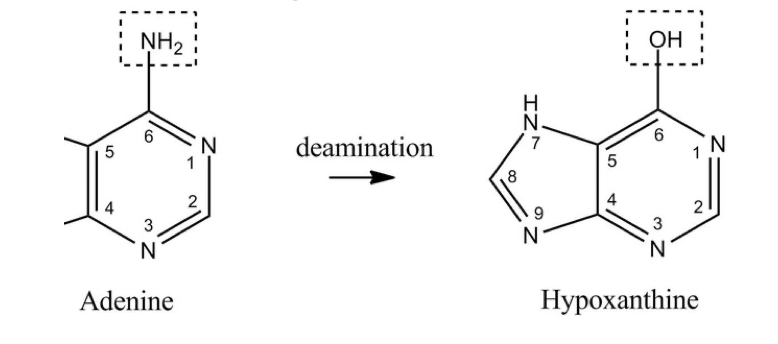
44
New cards
What are chemically induced intercalators?
Something is put in between the layers of DNA, the effect is that DNA poly stops working when it hits it
45
New cards
What is ionizing radiation induced mutations?
Ionizing radiation leads to free radical formation from ionized water that can break DNA strands and damage other macromolecules
46
New cards
What is UV radiation induced mutations?
UV radiation forms pyrimidine-dimers. Distorts shape of DNA, causing problems during replication. The result is often mismatches or deletions
47
New cards
True or false: Mutation frequency is very high
False: mutation frequency is only about 10^-8 per base pair
48
New cards
What are the 4 main repair mechanisms
Photoreactivation, Excision repair, SOS response, Homologous recombination
49
New cards
Photoreactivation
* repairs dimers
* activated by blue light
* photolyase binds to dimer → cuts bond between the dimers → photolyase leaves
* Humans do not do this
* activated by blue light
* photolyase binds to dimer → cuts bond between the dimers → photolyase leaves
* Humans do not do this
50
New cards
Excision repair
* the general response to damage
* basic or nucleotide excision
* multiple proteins and enzymes involved
* endonuclease
* DNA poly
* ligase
* found in all life
* basic or nucleotide excision
* multiple proteins and enzymes involved
* endonuclease
* DNA poly
* ligase
* found in all life
51
New cards
SOS response
* occurs in bacteria
* last resort, only occurs if normal repair systems can’t keep up with all of the damage
* RecA (sends SOS signal) cleaves LexA (can no longer prevent transcription), results in production of enzymes for repair
* Issue is that these repair enzymes are “sloppy”
* Goal is just to get genome replicated fast and repair as much as possible so the cell can divide and hopefully survive
* last resort, only occurs if normal repair systems can’t keep up with all of the damage
* RecA (sends SOS signal) cleaves LexA (can no longer prevent transcription), results in production of enzymes for repair
* Issue is that these repair enzymes are “sloppy”
* Goal is just to get genome replicated fast and repair as much as possible so the cell can divide and hopefully survive
52
New cards
Homologous recombination
* used to repair mistakes perfectly
* also used to repair DSB
* involves two double strands that are the exact (or nearly exact) same sequences
* tries to fix original so that it can divide again without error
* crossing over during meiosis is a version of this
* can be used as a template to fix errors/damage
* RecA is an important protein
* also used to repair DSB
* involves two double strands that are the exact (or nearly exact) same sequences
* tries to fix original so that it can divide again without error
* crossing over during meiosis is a version of this
* can be used as a template to fix errors/damage
* RecA is an important protein
53
New cards
Reverse mutation
* NOT a repair mechanism
* is a mutation of a mutation
* is a mutation of a mutation
54
New cards
What are the two ways to find/identify mutants?
Selections, scree, and ames test
55
New cards
Selections
* vast majority of cells die
* only cells with specific phenotypes will grow
* Ex. antibiotic resistance
* Ex. selective media
* only cells with specific phenotypes will grow
* Ex. antibiotic resistance
* Ex. selective media
56
New cards
Screen
* most cells grow, but a different phenotype is apparent
* Ex. differential media, MAC, lactose ferm
* Ex. phototroph vs autotroph
* phototroph: parent strain (WT) that does not have additional nutrient requirement
* Autotroph: mutants that require additional nutrients to grow
* Ex. differential media, MAC, lactose ferm
* Ex. phototroph vs autotroph
* phototroph: parent strain (WT) that does not have additional nutrient requirement
* Autotroph: mutants that require additional nutrients to grow
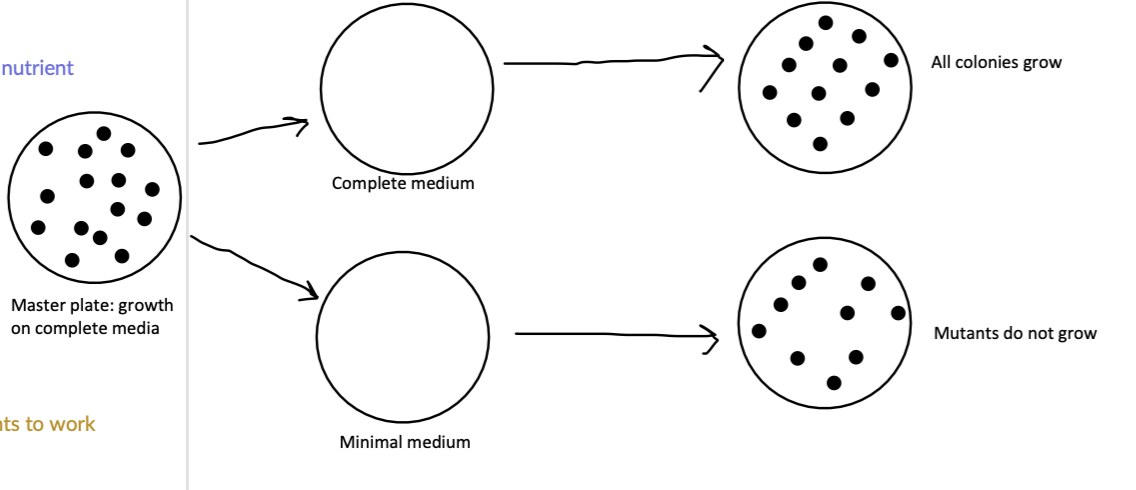
57
New cards
Ames test
rat liver thing
58
New cards
Transformation
* transfer of free “naked” DNA from environment
* Some bacteria are naturally competent (rare)
* some bacteria we can make competent in lab
* Some bacteria are naturally competent (rare)
* some bacteria we can make competent in lab
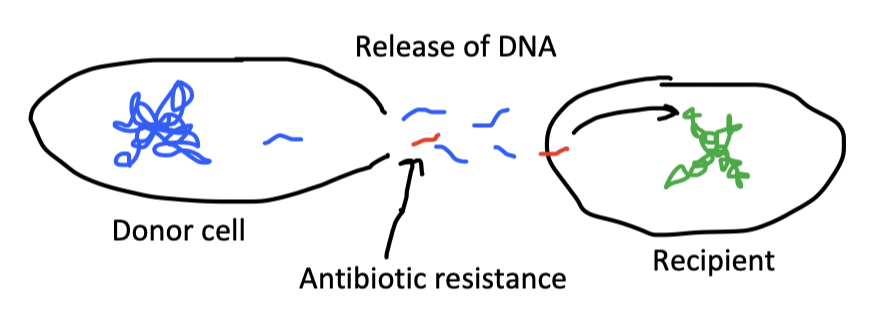
59
New cards
What types of genes are exchanged by transformation?
* any gene
* mostly random process
* to be maintained by the recipient cell, the gene must provide an advantage (or at least no disadvantage)
* mostly random process
* to be maintained by the recipient cell, the gene must provide an advantage (or at least no disadvantage)
60
New cards
Transduction
transfer of bacterial DNA from one cell to another by a phage
61
New cards
What are the two types of transduction
Generalized and specialized
62
New cards
Generalized transduction
any region (random) of the donor DNA can be transferred. If the new gene provided an advantage it would be selected over

63
New cards
Specialized transduction
only certain genes near the site of insertion of a lysogenic phage can be transferred. Doesn’t pick up a specific gene BUT it does pick up the gene that are next to the viral DNA (this is the “specialized” part)

64
New cards
What experiment was griffith’s?
The one with rough and smooth streptococcus in mice
65
New cards
What was Avery’s experiment?
The one with Streptococcus in mice as well as DNase, RNase, and proteinase
66
New cards
Why is it important that streptococcus is naturally competent?
Cause this allowed Griffith’s and Avery’s experiments to work
67
New cards
Conjugation
Transfer of DNA requiring cell-to-cell contact
first shown in 1946 by Joshua Lederberg, Ester Lederberg, and Ed Tatum
Plasmid is what’s being transferred
first shown in 1946 by Joshua Lederberg, Ester Lederberg, and Ed Tatum
Plasmid is what’s being transferred
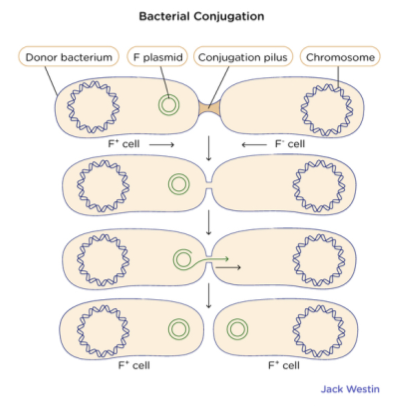
68
New cards
Plasmids
* Self replicating extrachromosomal DNA that is usually not essential for growth
* Usually smaller than chromosomes
* May encode beneficial products for specific growth conditions or environments
* Exchanged semi-frequently when it is advantageous
* Usually smaller than chromosomes
* May encode beneficial products for specific growth conditions or environments
* Exchanged semi-frequently when it is advantageous
69
New cards
Why do bacteria have plasmids?
* To “streamline” the genome
* To increase the coding capacity of the species
* Selfish genes
* To increase the coding capacity of the species
* Selfish genes
70
New cards
What is “streamlining” the genome?
bacterial cells want to divide rapidly so being able to get rid of genes that are not needed all the time is helpful
71
New cards
What are selfish genes
Plasmids that are viral like, which encode for proteins that promote the passage of the plasmid from one cell to another
72
New cards
Why exchange DNA?
* DNA can be used as a nutrient source
* “Fresh” DNA can be used for repair mechanisms (especially via homologous recombination)
* DNA transfer allows for the exchange of genetic material
* “Fresh” DNA can be used for repair mechanisms (especially via homologous recombination)
* DNA transfer allows for the exchange of genetic material
73
New cards
What are the effects of DNA transfer allowing for the exchange of genetic material
* New genes can be put into a genome
* Increased variability
* Rapid evolution (not small mutations that are slowly selected on, multiple genes being transfered at once)
* This happens ALL OF THE TIME
* Increased variability
* Rapid evolution (not small mutations that are slowly selected on, multiple genes being transfered at once)
* This happens ALL OF THE TIME
74
New cards
Genetic engineering
* Use the transfer of DNA
* Techniques for manipulating the nucleic acid of an organism
* Bacterial genetics is the foundation of modern molecular genetics
* Call this “cloning” because bacteria are clones
* GMOs are based on tech developed from or in bacteria
* Techniques for manipulating the nucleic acid of an organism
* Bacterial genetics is the foundation of modern molecular genetics
* Call this “cloning” because bacteria are clones
* GMOs are based on tech developed from or in bacteria
75
New cards
Plasmids as cloning vectors
* Replicated independent of the genome to multicopy per cell
* Small, easy to isolate DNA, simple to transform into hots (gene → plasmid → host)
* Contains selectable markers
* Small, easy to isolate DNA, simple to transform into hots (gene → plasmid → host)
* Contains selectable markers
76
New cards
Properties of cloning vectors
* ORI (origin of replication)
* MCS (multiple cloning site)
* Selectable marker
* Stably maintained in host
* MCS (multiple cloning site)
* Selectable marker
* Stably maintained in host
77
New cards
Why is ORI important when it come to cloning
If you want to put a plasmid in E. coli the plasmid has to have ORI that E. coli will recognize
78
New cards
What is the MCS
spot in the plasmid where we put foreign DNA
79
New cards
Molecular cloning
isolation and incorporation of a piece of DNA into a vector so it can be manipulated and replicated
80
New cards
What are the three main steps of molecular cloning
1. Isolation and cut source DNA with restriction enzymes OR generate fragments by PCR
2. Insertion of DNA fragment into cloning vector (plasmid), the DNA ligase covalently connects DNA fragments together through a phosphodiester bond
3. Introduction of cloned DNA into host organism
81
New cards
Recombinant DNA
DNA that we generate/modify through molecular techniques and use to put into an organism
82
New cards
Restriction enzymes
cuts DNA at a specific base sequence (palindromes), this leaves complementary ends that can be ligated back together in research specific recombinants
83
New cards
Applications
Medicine, drugs, antibiotics, vaccine
84
New cards
Genetically modified organisms
Research of gene function (making stuff glow)
Most crops are already already GMO
Most crops are already already GMO
85
New cards
CRISPR
Bacterial immune system that specifically cuts phage DNA inside an infected cell
86
New cards
Basics of viruses
Acellular genetic element that cannot replicate independently of a living host cell.
87
New cards
Size of viruses
Significantly smaller than prokaryotes
Range from .02 - 3 um
First discovered because they passed through filters that caught bacteria
Range from .02 - 3 um
First discovered because they passed through filters that caught bacteria
88
New cards
Are viruses alive?
Order = yes
Process energy (metabolism) = No, but they can influence host metabolism
Regulation = yes (can control gene expression and how/what proteins are made)
Response to environment = yes (can control gene expression and how/what proteins are made)
Growth and development = No
Reproduction = No, they do have a lot of central dogma machinery but they’re always missing ribosomes
Evolutionary adaptation = yes
Process energy (metabolism) = No, but they can influence host metabolism
Regulation = yes (can control gene expression and how/what proteins are made)
Response to environment = yes (can control gene expression and how/what proteins are made)
Growth and development = No
Reproduction = No, they do have a lot of central dogma machinery but they’re always missing ribosomes
Evolutionary adaptation = yes
89
New cards
Components of all viruses
* Made up of a viral genome + protein
* protein = capsid (surrounds viral nucleic acid)
* nucleocapsid (basically the viral particle) = capsid + nucleic acid
* Shapes = helical or icosahedral
* protein = capsid (surrounds viral nucleic acid)
* nucleocapsid (basically the viral particle) = capsid + nucleic acid
* Shapes = helical or icosahedral
90
New cards
Some viruses
* Some contain an envelope that surrounds the nucleocapsid
* Some contain other proteins/enzymes
* DNA or RNA poly
* Tegument proteins
* Specific examples of enveloped proteins
* Some contain other proteins/enzymes
* DNA or RNA poly
* Tegument proteins
* Specific examples of enveloped proteins
91
New cards
Tegument proteins
* space between capsid and envelop, called tegument, contains them
* can be virus or host derived
* delivered to host cell at same time as virus
* allows virus to take over cell and get it to do what it wants
* can be virus or host derived
* delivered to host cell at same time as virus
* allows virus to take over cell and get it to do what it wants
92
New cards
Give an example of enveloped proteins
Spike protein on corona virus
93
New cards
Viral genome
all are nucleic acids, most are linear genomes, can be DNA or RNA
94
New cards
Steps of viral replication
Attachment
Entry
Synthesis
Assembly
Release
Entry
Synthesis
Assembly
Release
95
New cards
Growth curve of viruses
1 step because viruses are released almost simultaneously so the latent period is very long (eclipse and maturation) while the burst (assembly and release) is quick and at the end
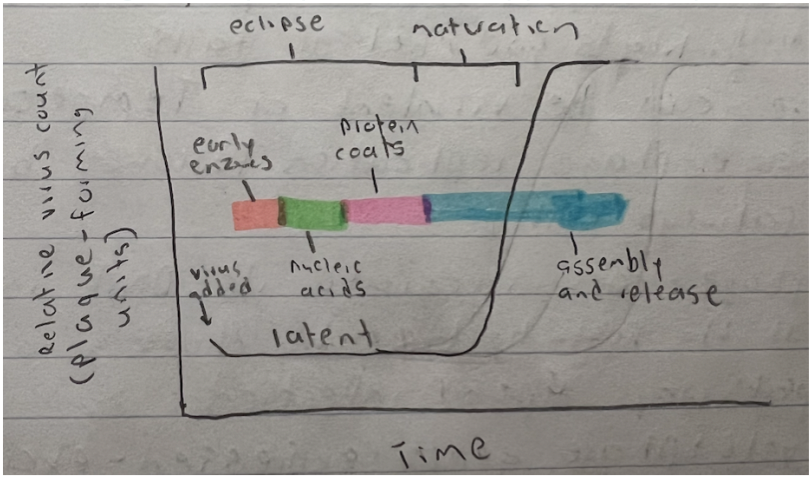
96
New cards
Plaque assay
Titer = number of units per volume of fluid
Plaque assay = dilute virus sample → mix with cells in cell culture → look for zones of clearing called plaques
Plaque forming unit = one viable viral partical
Have to plate the host cell first then virus
Plaque assay = dilute virus sample → mix with cells in cell culture → look for zones of clearing called plaques
Plaque forming unit = one viable viral partical
Have to plate the host cell first then virus
97
New cards
Bacteriophage
Viruses that infect bacteria
98
New cards
Virulent phages
phage replication followed by host lysis
99
New cards
Temperate phages
Can integrate its DNA into the host DNA OR kill the host by lysis by choosing a lysogenic and a lytic pathway upon infection
100
New cards
Lytic cycle
phage genes expressed → excised from genome if previously lysogenic → kills host